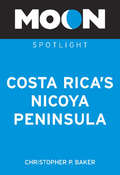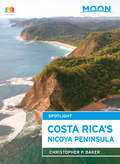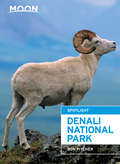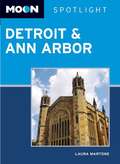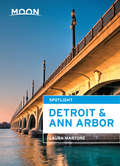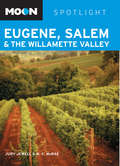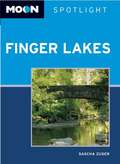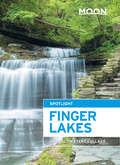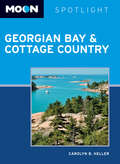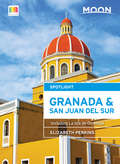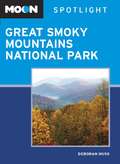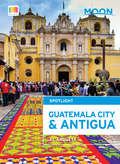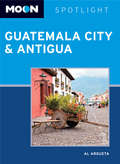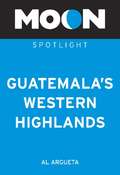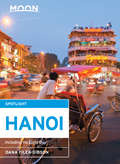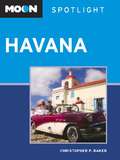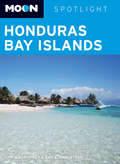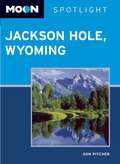- Table View
- List View
Moon Spotlight Costa Rica's Nicoya Peninsula: 2009
by Christopher P. BakerMoon Spotlight Costa Rica's Nicoya Peninsulais an 88-page compact guide covering Costa Rica's Nicoya Peninsula, including Highway 2 to Santa Cruz, Playas del Coco, Playa Flamingo, Tamarindo, Junquilal, Nosara, and Southern Nicoya. Author Christopher P. Baker offers his firsthand advice on what sights are must-sees, and sightseeing highlights maps make planning your time easy. This lightweight guide is packed with recommendations on sights, entertainment, shopping, recreation, accommodations, food, and transportation; and helpful maps guide travelers through the best of beachside Costa Rica. This Spotlight guidebook is excerpted fromMoon Costa Rica.
Moon Spotlight Costa Rica's Nicoya Peninsula: 2011
by Christopher P. BakerMoon Spotlight Costa Rica's Nicoya Peninsula is an 88-page compact guide covering Costa Rica's Nicoya Peninsula, including Highway 2 to Santa Cruz, Playas del Coco, Playa Flamingo, Tamarindo, Junquilal, Nosara, and Southern Nicoya. Author Christopher P. Baker offers his firsthand advice on what sights are must-sees, and sightseeing highlights maps make planning your time easy. This lightweight guide is packed with recommendations on sights, entertainment, shopping, recreation, accommodations, food, and transportation; and helpful maps guide travelers through the best of beachside Costa Rica.This Spotlight guidebook is excerpted from Moon Costa Rica.
Moon Spotlight Costa Rica's Nicoya Peninsula: 2015
by Christopher P. BakerMoon Spotlight Costa Rica's Nicoya Peninsula is a 97-page compact guide covering Costa Rica's Nicoya Peninsula, including Highway 2 to Santa Cruz, Playas del Coco, Playa Flamingo, Tamarindo, Junquilal, Nosara, and Southern Nicoya. Author Christopher P. Baker offers his firsthand advice on what sights are must-sees, and sightseeing highlights maps make planning your time easy. This lightweight guide is packed with recommendations on sights, entertainment, shopping, recreation, accommodations, food, and transportation; and helpful maps guide travelers through the best of beachside Costa Rica.This Spotlight guidebook is excerpted from Moon Costa Rica.
Moon Spotlight Cozumel and the Riviera Maya
by Gary Chandler Liza PradoMoon Spotlight Cozumel and the Riviera Mayais an 88-page compact guide covering Puerto Morelos, Playa Xcalacoco, Playa del Carmen, Puerto Aventuras, Akumal, and Tankah Tres. Authors Liza Prado and Gary Chandler offer their seasoned advice on must-see attractions, and include maps with sightseeing highlights so you can make the most of your time. This lightweight guide is packed with recommendations on entertainment, shopping, recreation, accommodations, food, and transportation, making navigating Mexico’s Caribbean coast uncomplicated and enjoyable.
Moon Spotlight Delhi
by Margot BiggMoon Spotlight Delhi is a 65-page compact guide covering the best of India's capital city. Travel writer Margot Bigg offers her firsthand advice on must-see attractions, as well as maps with sightseeing highlights, so you can make the most of your time. This lightweight guide is packed with recommendations on entertainment, shopping, recreations, accommodations, food, and transportation, making navigating this bustling metropolis uncomplicated and enjoyable. This Spotlight guidebook is excerpted from Moon Taj Mahal, Delhi & Jaipur.
Moon Spotlight Denali National Park
by Don PitcherMoon Spotlight Denali National Park is a 55-page compact guide covering the wonders of this Alaskan national park. Author Don Pitcher offers his seasoned advice on must-see attractions, and he includes maps with sightseeing highlights so you can make the most of your time. This lightweight guide is packed with recommendations on entertainment, shopping, recreation, accommodations, food, and transportation, making navigating the park uncomplicated and enjoyable.This Spotlight guidebook is excerpted from Moon Anchorage, Denali & the Kenai Peninsula.
Moon Spotlight Detroit & Ann Arbor: 2011
by Laura MartoneMoon Spotlight Detroit & Ann Arbor is a 78-page compact guide covering the best of Southern Michigan, including Detroit's treasured Belle Isle and one-of-a-kind The Henry Ford, the University of Michigan in Ann Arbor, and the W.K. Kellogg Bird Sanctuary, one of America's pioneer wildlife conservation centers. Author Laura Martone offers seasoned advice on must-see attractions, and includes maps with sightseeing highlights so you can make the most of your time. This lightweight guide is packed with recommendations on entertainment, shopping, recreations, accommodations, food, and transportation, making navigating these diverse areas uncomplicated and enjoyable.
Moon Spotlight Detroit & Ann Arbor: 2014
by Laura MartoneMoon Spotlight Detroit & Ann Arbor is a 110-page compact guide covering the best of Southern Michigan, including Detroit's treasured Belle Isle and one-of-a-kind The Henry Ford, the University of Michigan in Ann Arbor, and the W.K. Kellogg Bird Sanctuary, one of America's pioneer wildlife conservation centers. Author Laura Martone offers seasoned advice on must-see attractions, and includes maps with sightseeing highlights so you can make the most of your time. This lightweight guide is packed with recommendations on sights, entertainment, shopping, recreations, accommodations, food, and transportation, as well as easy-to-read maps, making navigating these diverse areas uncomplicated and enjoyable.This Spotlight guidebook is excerpted from Moon Michigan.
Moon Spotlight Eugene, Salem, & the Willamette Valley
by W. C. Mcrae Judy JewellMoon Spotlight Eugene, Salem & the Willamette Valley is a 70-page compact guide covering the best of Oregon's largely rural region, including wine country, Champoeg State Park, and Corvallis. Travel writers Judy Jewell and W. C. McRae offer their firsthand advice on what sights are must-sees, and sightseeing highlight maps make planning your time easy. This lightweight guide is packed with recommendations on entertainment, shopping, recreation, accommodations, food, and transportation, making navigating these popular Oregon towns uncomplicated and enjoyable.
Moon Spotlight Finger Lakes: 2010
by Sascha ZugerMoon Spotlight Finger Lakes is a 65-page compact guide covering the highlights of this scenic region, including picturesque Skaneateles Village, the historic Women's Rights National Historical Park, and the remarkable Corning Museum of Glass. Author Sascha Zuger offers her seasoned advice on must-see attractions, and she includes maps with sightseeing highlights so you can make the most of your time. This lightweight guide is packed with recommendations on entertainment, shopping, recreations, accommodations, food, and transportation, making navigating these singular locations uncomplicated and enjoyable.
Moon Spotlight Finger Lakes: 2014
by Julie Schwietert CollazoMoon Spotlight Finger Lakes is a 90-page compact guide covering the highlights of this scenic region, including picturesque Skaneateles Village, the historic Women's Rights National Historical Park, and the remarkable Corning Museum of Glass. Author Julie Schwietert Collazo offers her seasoned advice on must-see attractions, and she includes maps with sightseeing highlights so you can make the most of your time. This lightweight guide is packed with recommendations on sights, entertainment, shopping, recreations, accommodations, food, and transportation, as well as easy-to-read maps, making navigating these singular locations uncomplicated and enjoyable.This Spotlight guidebook is excerpted from Moon New York State.
Moon Spotlight Georgian Bay & Cottage Country
by Carolyn HellerMoon Spotlight Georgian Bay & Cottage Country is a 70-page compact guide covering the best of south-central Ontario. Professional travel writer Carolyn B. Heller offers her firsthand advice on must-see attractions, as well as maps with sightseeing highlights, so you can make the most of your time. This lightweight guide is packed with recommendations on entertainment, shopping, recreation, accommodations, food, and transportation, making navigating this strikingly beautiful region of Ontario uncomplicated and enjoyable.
Moon Spotlight Georgian Bay & Cottage Country: 2015
by Carolyn HellerMoon Spotlight Georgian Bay & Cottage Country is a 112-page compact guide covering the best of south-central Ontario. Professional travel writer Carolyn B. Heller offers her firsthand advice on must-see attractions, as well as maps with sightseeing highlights, so you can make the most of your time. This lightweight guide is packed with recommendations on entertainment, shopping, recreation, accommodations, food, and transportation, making navigating this strikingly beautiful region of Ontario uncomplicated and enjoyable.This Spotlight guide is excerpted from Moon Ontario.
Moon Spotlight Granada & San Juan del Sur
by Elizabeth PerkinsMoon Spotlight Granada & San Juan del Sur is a 100-page compact guide that combines Nicaragua's best culture and history with outdoor recreation. Nicaragua expert Elizabeth Perkins offers her firsthand advice on must-see attractions in Masaya and the Publos Blancos, La Isla de Ometepe and Rivas, and San Juan del Sur and the Southwest Coast, as well as maps with sightseeing highlights, so you can make the most of your time. This lightweight guide is packed with recommendations on entertainment, shopping, recreation, hotels, food, and transportation, making navigating these exciting destinations uncomplicated and enjoyable.This full-color Spotlight guidebook is excerpted from Moon Nicaragua.
Moon Spotlight Great Smoky Mountains National Park
by Deborah HusoMoon Spotlight Great Smoky Mountains National Park is a 90-page compact guide covering the Newfound Gap Road, Cades Cove, Clingmans Dome, and Alum Cave Bluffs Trail. Author Deborah Huso offers her seasoned advice on must-see attractions, and includes maps with sightseeing highlights so you can make the most of your time. This lightweight guide is packed with recommendations on entertainment, shopping, recreations, accommodations, food, and transportation, making navigating this popular national park uncomplicated and enjoyable.
Moon Spotlight Guatemala City & Antigua
by Al ArguetaMoon Spotlight Guatemala City and Antigua is an 80-page compact guide covering the gateway city of Guatemala and neighboring La Antigua. Author Al Argueta offers his firsthand advice on must-see attractions, as well as maps with sightseeing highlights, so you can make the most of your time. This lightweight guide is packed with recommendations on entertainment, shopping, recreation, accommodations, food, and transportation, making navigating modern Guatemala City and charming, history-filled Antigua uncomplicated and enjoyable. This full-color Spotlight guidebook is excerpted from Moon Guatemala.
Moon Spotlight Guatemala City & Antigua: 2012
by Al ArguetaMoon Spotlight Guatemala City and Antigua is an 80-page compact guide covering the gateway city of Guatemala and neighboring La Antigua. Author Al Argueta offers his firsthand advice on must-see attractions, as well as maps with sightseeing highlights, so you can make the most of your time. This lightweight guide is packed with recommendations on entertainment, shopping, recreation, accommodations, food, and transportation, making navigating modern Guatemala City and charming, history-filled Antigua uncomplicated and enjoyable.This Spotlight guidebook is excerpted from Moon Guatemala.
Moon Spotlight Guatemala City and Antigua: 2010
by Al ArguetaMoon Spotlight Guatemala City and Antiguais an 80-page compact guide covering the gateway city of Guatemala and neighboring La Antigua. Author Al Argueta offers his seasoned advice on what sights are must-see and includes a map with sightseeing highlights so planning your time is easy. This lightweight guide is packed with recommendations on sights, entertainment, shopping, accommodations, food, and transportation. Helpful maps make navigating Guatemala City and Antigua uncomplicated. This Spotlight guidebook is excerpted fromMoon Guatemala.
Moon Spotlight Guatemala's Western Highlands
by Al ArguetaMoon Spotlight Guatemala's Western Highlands is an 80-page compact guide covering a region boasting Central America's highest mountains and volcanoes, along with its most authentic indigenous culture. Author Al Argueta offers his seasoned advice on what sights are must-sees and includes maps with sightseeing highlights so planning your time is easy. This lightweight guide is packed with recommendations on sights, entertainment, shopping, recreations, accommodations, food, and transportation. Helpful maps make navigating this spectacular region uncomplicated.This Spotlight guidebook is excerpted from Moon Guatemala.
Moon Spotlight Hanoi
by Dana Filek-GibsonMoon Spotlight Hanoi is a 100-page compact guide covering Vietnam's capital, as well as surrounding areas. Author Dana Filek-Gibson offers her seasoned advice on must-see attractions, and she includes maps with sightseeing highlights so you can make the most of your time. This lightweight guide is packed with recommendations on entertainment, shopping, recreation, accommodations, food, and transportation, making navigating this fascinating city uncomplicated and enjoyable. This Spotlight guidebook is excerpted from Moon Vietnam.
Moon Spotlight Havana
by Christopher P. BakerMoon Spotlight Havanaoffers focused travel information and the unique perspective of award-winning travel writer Christopher P. Baker. In this easy-to-carry guide, you’ll find sightseeing highlights, handy maps, and shopping, restaurant, and hotel recommendations. Included are options fromcasas particulares(room rentals) to retro-1950s grande dame hotels, and humble home-basedpaladaresor five-star restaurants. Walking tours take you through some of Havana’s most interesting neighborhoods and streets such as The Prado, Zulueta and Monserrate, Calle Obispo, and Plaza Vieja. Packed with great ideas and advice,Moon Spotlight Havanais all you’ll need for a memorable getaway to this fascinating city. This Spotlight guidebook is excerpted fromMoon Cuba.
Moon Spotlight Ho Chi Minh City (Saigon)
by Dana Filek-GibsonMoon Spotlight Ho Chi Minh City (Saigon) is a 100-page compact guide covering the city of Saigon, as well as surrounding areas. Author Dana Filek-Gibson offers her seasoned advice on must-see attractions, and she includes maps with sightseeing highlights so you can make the most of your time. This lightweight guide is packed with recommendations on entertainment, shopping, recreation, accommodations, food, and transportation, making navigating this multifaceted city uncomplicated and enjoyable. This Spotlight guidebook is excerpted from Moon Vietnam.
Moon Spotlight Honduras Bay Islands
by Amy E. Robertson Chris HumphreyMoon Spotlight Honduras Bay Islands is a 65-page compact guide covering the best of the Bay Islands. Travel writer Amy E. Robertson offer her firsthand advice on what you shouldn't miss, and sightseeing highlights maps make planning your time easy. This lightweight guide is packed with recommendations on sights, entertainment, shopping, recreation, accommodations, food, and transportation. Helpful maps guide travelers through the lush forests and sun-kissed beaches of this emerging travel destination.This Spotlight guidebook is excerpted from Moon Honduras & the Bay Islands.
Moon Spotlight Houston and the Texas Gulf Coast
by Andy RhodesMoon Spotlight Houston & the Texas Gulf Coast is a 100-page compact guide covering Houston, East Texas, and the Gulf Coast of Texas. Journalist Andy Rhodes offers his seasoned advice on must-see attractions, and includes maps with sightseeing highlights so you can make the most of your time. This lightweight guide is packed with recommendations on entertainment, shopping, recreations, accommodations, food, and transportation, making navigating this interesting region of the Lone Star State uncomplicated and enjoyable.
Moon Spotlight Jackson Hole, Wyoming
by Don PitcherMoon Spotlight Jackson Hole, Wyoming is a 90-page compact guide covering Wyoming's most famous inter-mountain valley. Author Don Pitcher offers his seasoned advice on must-see attractions, and includes maps with sightseeing highlights so you can make the most of your time. This lightweight guide is packed with recommendations on entertainment, shopping, recreations, accommodations, food, and transportation, making navigating Jackson Hole uncomplicated and enjoyable.
